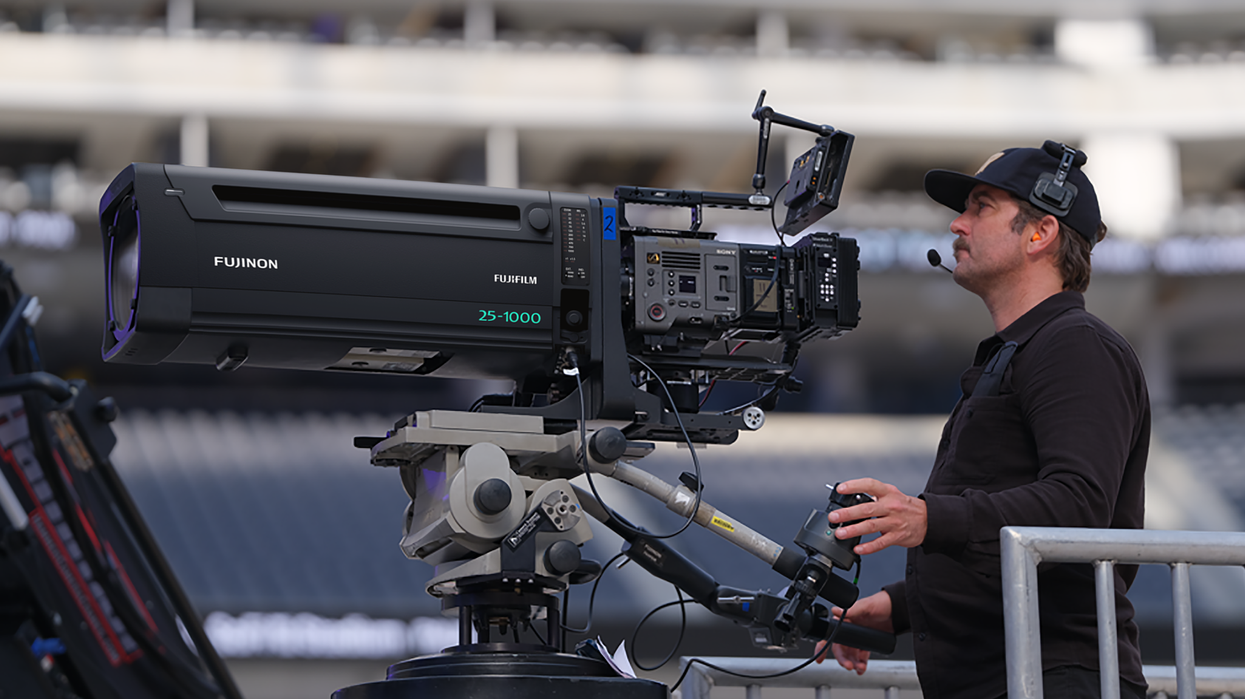Fujifilm Just Launched a Super 35 PL Mount Box Lens That Filmmakers Will Adore
Fujifilm launches a new lens for broadcast folks that filmmakers should still have on their radar (even if they can't afford it).

A box lens isn't something narrative filmmakers think much about. Traditionally focused on broadcast production, especially sports and live concert work, a box lens features an incredibly long zoom range that allows you to get close to the action from the sidelines. Even from the nosebleeds.
The quality has always been broadcast-focused, with its smaller sensor and different imaging needs (broadcast images go out immediately and don't get corrected), so these rarely show up in narrative work. But the new Fujifilm HZK 25-1000mm might change that.
Even if you don't need an ultra-long zoom soon, you should still have it on your radar.
Bigger Sensors for Broadcast
Driven by the increasing presence of Super 35 and even larger sensors at sporting events and especially concerts, and the drive to create more "cinematic" imagery even in broadcast, Fuji has designed the HZK 25-1,000mm as a new kind of box lens. It features an astounding 40x zoom range, all the way from 25mm at its widest to 1000mm at its longest.

It covers a Super 35 image circle and comes in a PL mount. Using an extender, operators can push out to 1500mm if they need it for some insane reason. It can also expand the image to work with Large Format sensors.
The lens works both with broadcast-style focus and zoom controls, but also with your film-style Preston and ARRI focus and zoom controls. At its widest, the lens opens to an f/2.8, which is excellent for low-light concert work. At 1000mm, this comes down to an f/5, which is still pretty impressive for such a long lens.

Like all broadcast lenses, the Fujifilm HZK comes with built-in image stabilization. If you are already a Fuji shooter, you know that Fuji has great lens stabilization tech, which you want for long lens work. Even on a tripod, if there are vibrations where you are shooting (as there might be when a concert cranks or crowd chants), you want to tune that out, and this lens does that.
This is one of those areas where the large footprint of Fujifilm comes into play. The optical elements and look of this lens come from the Premiere series of high-end cinema zooms, but that image stabilization tech was really refined and pushed to scale on the X-series of cameras and lenses. It all comes together in a new way with this lens.
Focusing This Monster
That integration with Preston and ARRI autofocus that we mentioned? It opens up some pretty cool options in terms of integrating into a larger cinema workflow.
For instance, the Cinefade system can rack a variable ND filter to vary your depth of field. That requires working with a traditional cinema follow focus units such as the ARRI WCU-4, which works with this lens, opening up interesting creative possibilities.
Fujifilm has also specifically focused not just on the optical design for the in-focus areas but deliberated worked to craft a soft, pleasing out-of-focus "bokeh" area. Bokeh is one of those things that can separate a "blah" lens from one that really sings. And early tests that have been shown off are pretty impressive for creating a pleasing bokeh.

A Box Lens for Film?
We shouldn't forget that 1000mm is famously the Lawrence of Arabia focal length. Panavision custom-crafted a 1000mm lens to allow David Lean to shoot those amazing shots of a rider coming over the horizon with shimmers of heat in the way. 1000mm was also the focal length that Clairmont crafted as a special-purpose lens that showed up on countless productions (and that I've had the pleasure of shooting a few times). 1000 doesn't feel like a random number to hit for their long-range here.
Obviously, it's a fun number from a marketing perspective, but it also feels like a "cinematic" number.

So why should a filmmaker care about a broadcast-focused box lens? Well, because sometimes we love to do a really, really long zoom. The nature of a box lens means you likely won't be able to do that "snap zoom" you loved in Kill Bill (you really need a ring zoom for that), but if you require an immense amount of zoom range, something like a box zoom is something to think about. Maybe it's an action scene, and you want to keep your frame on a car that comes at you for an astounding amount of time. This lens is a real option with its 40x range. Or if you have a sequence set at a concert or sporting event.
This will be the lens to rent. And we mean rent. With this piece of kit, if you have to ask how much it costs, you can't afford it.
Leave your reactions in the comments.
Check out weekly specials, deals, and rebates: Pro Video Gear, Pro Audio Gear, Lighting

 "'Back Home"via Mercedes Arutro
"'Back Home"via Mercedes Arutro 'Back Home'via Mercedes Arutro
'Back Home'via Mercedes Arutro 









